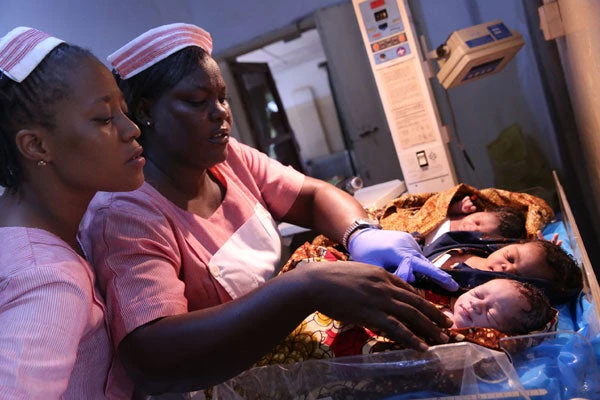
Forty-five years ago, the World Bank began a major shift in its approach to development. Prior to the 1970s, the Bank’s overwhelming focus was on infrastructure projects, consistent with our origins as an agency focused on post World War II reconstruction. The later shift came with recognition that sustained economic development had a lot to do with human development, not just physical development, which led to our first projects on population. In the early years, these focused on the Caribbean, North Africa and South and East Asia, and were underpinned by recognition that population dynamics have direct impact on poverty, health, human capital and economic growth.
Fast forward 40 years: That recognition remains strong, but the Bank’s work on population and development has shifted geographically, to fulfill an unfinished agenda in one region, and develop a new agenda in many other regions.
The unfinished agenda is mostly focused on sub-Saharan Africa, where fertility rates are the highest in the world, and the majority of countries are struggling under the weight of bottom-heavy population pyramids.
In conjunction with the upcoming World Bank/IMF annual meeting in Lima, Peru, this October, the Bank will release a new book, The Demographic Transition in Africa: Dividend or Disaster, to reinforce the strong links between fertility and economic development. Without effective policies and programs related to child health, girl’s education, women’s empowerment, and family planning services, not only will the majority of countries in Sub-Saharan Africa miss out on the “demographic dividend,” they could face a potential disaster linked to increased poverty, lower human capital, high maternal mortality, and a potential for political instability. Policies can make the difference. The situation is particularly urgent in West Africa and the Sahel region where fertility is the highest in the world.
The relatively new population agenda is related to the other end of the demographic transition, that is, of population aging in countries that have reached or are reaching fertility levels below replacement. The World Bank has produced a number of recent regional and country reports on this transition in Eastern Europe and Central Asia, Latin America and the Caribbean and East Asia and the Pacific, addressing the impact of sustained low fertility and rapid population aging on the way societies and economies operate. Moreover, the Bank’s upcoming 2015 Global Monitoring Report, also to be launched in Lima, will feature demography as a special topic.
To address the challenges and take advantage of the opportunities associated with an increasingly older population age structure, a well-designed and implemented policy response is needed over a prolonged period of time. In particular, labor force participation needs to be increased by providing employment opportunities to groups who are traditionally excluded, women in particular. Productivity needs to be increased at all ages by ensuring that basic education of good quality is available to all student-age population in all socioeconomic groups and by strengthening life-long learning for workers across the life cycles.
Fiscal pressures on social protection and health expenditures arising from an increasingly larger share of elderly need to be managed with efficiency and equity. Savings need to be incentivized by well-functioning financial systems, and resulting higher savings need to be used to increase human and physical capital accumulation. Each country will have to analyze and understand its own demographic situation and define a specific response that reflects institutions and preferences of its society. It’s important to start now since institutional changes are usually difficult to negotiate among many stakeholders. International experience shows that, the longer reforms are delayed, the greater the need.
In many ways, socioeconomic development is not a sexy topic. It is slow and policy-driven, but extremely important to the lives of billions around the globe, especially those in the bottom 40% of the wealth scale. The global community does not react well to slow and wonk-ish topics. But the reality is that socioeconomic development has a huge impact on the well-being of the poorest among us, and failure to address systemic factors in development leaves the global community lurching from one short-term crisis to another.
The links between demographic change and socioeconomic development are strong, and the outcomes of the interplay between population dynamics, societies and economies are the result of policy decisions, which require long-term vision and commitment from politicians and policymakers. Demographic change is incredibly slow, taking decades to manifest, yet it is amazingly predictable and fantastically responsive to policies.
On this year’s World Population Day, and almost 45 years since the Bank’s first engagement on population and development, demography continues to be one of the topics central to our twin objectives of eliminating extreme poverty and promoting shared prosperity.
Follow the World Bank Health team on Twitter: @WBG_Health
Related
Project Appraisal: Sahel Women’s Empowerment and Demographic Dividend Project
From Red to Gray: The Third Transition of Aging Populations in Eastern Europe and the Former Soviet Union (2007)
Population Aging: Is Latin America Ready (2010)
Growing Old in an Older Brazil: Implications of Population Aging on Growth, Poverty, Public Finance and Service Delivery (2011)
As Times Goes by in Argentina: Economic Opportunities and Challenges of the Demographic Transition (2015)
Golden Aging: Prospects for Healthy, Active and Prosperous Aging in Europe and Central Asia (2015)



Join the Conversation